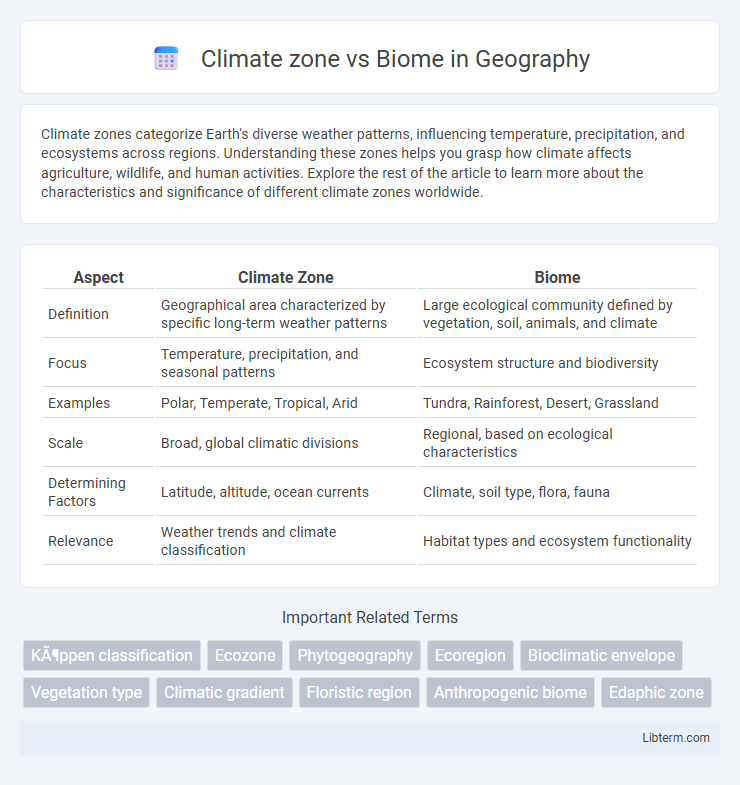Climate zones categorize Earth's diverse weather patterns, influencing temperature, precipitation, and ecosystems across regions. Understanding these zones helps you grasp how climate affects agriculture, wildlife, and human activities. Explore the rest of the article to learn more about the characteristics and significance of different climate zones worldwide.
Table of Comparison
| Aspect | Climate Zone | Biome |
|---|---|---|
| Definition | Geographical area characterized by specific long-term weather patterns | Large ecological community defined by vegetation, soil, animals, and climate |
| Focus | Temperature, precipitation, and seasonal patterns | Ecosystem structure and biodiversity |
| Examples | Polar, Temperate, Tropical, Arid | Tundra, Rainforest, Desert, Grassland |
| Scale | Broad, global climatic divisions | Regional, based on ecological characteristics |
| Determining Factors | Latitude, altitude, ocean currents | Climate, soil type, flora, fauna |
| Relevance | Weather trends and climate classification | Habitat types and ecosystem functionality |
Defining Climate Zones: Key Characteristics
Climate zones are defined by consistent temperature ranges, precipitation patterns, and seasonal variations that influence local weather conditions. Key characteristics include temperature averages, annual rainfall, humidity levels, and dominant wind patterns, which collectively shape the environment. These zones, such as tropical, temperate, and polar, determine the foundational climate conditions that impact native ecosystems and species distributions.
Understanding Biomes: Nature’s Diverse Communities
Biomes represent nature's diverse communities, defined by the adaptation of plants and animals to specific environmental conditions rather than just climate variables. While climate zones categorize regions based on temperature and precipitation patterns, biomes integrate these factors with soil type, altitude, and biological interactions to create distinct ecosystems like tropical rainforests, deserts, or tundras. This holistic approach enhances understanding of biodiversity patterns and ecosystem functions across the planet.
Key Differences Between Climate Zones and Biomes
Climate zones are classified based on long-term temperature and precipitation patterns, influencing the overall weather conditions of a region. Biomes encompass communities of plants, animals, and microorganisms adapted to specific climate zones, soil types, and geographical features. The key difference lies in climate zones describing atmospheric conditions while biomes represent ecological communities shaped by those climatic factors.
The Role of Climate in Shaping Biomes
Climate zones, defined by temperature and precipitation patterns, directly influence the distribution and characteristics of biomes by determining the types of vegetation and animal species that can thrive in an area. For example, tropical climate zones support rainforests with high biodiversity, while arid climate zones give rise to deserts with sparse vegetation. The interaction between temperature, rainfall, and seasonal variations within these climate zones shapes the structural composition and ecological functions of biomes worldwide.
Types of Climate Zones Worldwide
Climate zones worldwide are typically categorized into tropical, temperate, polar, arid, and Mediterranean zones, each defined by specific temperature and precipitation patterns. These climate zones influence the distribution and characteristics of biomes, such as tropical rainforests in tropical zones, tundra in polar zones, and deserts in arid zones. Understanding the types of climate zones allows for predicting biome locations and ecological diversity across different regions of the Earth.
Major Biome Categories and Their Features
Major biome categories include tropical rainforests, deserts, temperate forests, grasslands, tundras, and boreal forests, each characterized by distinct climatic conditions and vegetation types. Tropical rainforests feature high rainfall and biodiversity, deserts have scarce precipitation and specialized drought-resistant flora, while temperate forests exhibit moderate temperatures with deciduous and coniferous trees. Grasslands, dominated by grasses and few trees, support herbivores, tundras have low temperatures with permafrost and mosses, and boreal forests consist mainly of coniferous trees adapted to cold climates.
How Geography Influences Climate Zones
Geography plays a crucial role in shaping climate zones by affecting temperature, precipitation, and atmospheric circulation patterns. Factors such as latitude, altitude, proximity to oceans, and mountain ranges determine the variation in solar radiation and moisture availability, resulting in distinct climate zones. These geographic features create diverse environmental conditions that influence the distribution and characteristics of various biomes across the globe.
Human Impacts on Climate Zones and Biomes
Human activities such as deforestation, urbanization, and greenhouse gas emissions are significantly altering climate zones by shifting temperature and precipitation patterns. These changes disrupt biomes, leading to habitat loss, reduced biodiversity, and altered ecosystem services. The accelerated impact of climate change intensifies stress on sensitive biomes like tropical rainforests and arctic tundras, challenging their resilience and capacity to support human livelihoods.
Adapting to Change: Climate Zones vs. Biomes
Climate zones are classified based on long-term atmospheric conditions such as temperature and precipitation patterns, directly influencing local weather and seasonal cycles. Biomes represent large ecological areas characterized by specific plant and animal communities adapted to these climate conditions, reflecting the complex interactions between climate and living organisms. Adapting to change requires understanding how shifts in climate zones alter environmental parameters, consequently affecting biome distribution and the survival strategies of species within those biomes.
Preserving Earth's Climate Zones and Biomes
Preserving Earth's climate zones and biomes is essential for maintaining biodiversity and ecosystem stability, as each zone supports unique flora and fauna adapted to specific environmental conditions. Climate zones, defined by long-term temperature and precipitation patterns, directly influence the distribution and health of biomes, including tropical rainforests, deserts, and tundras. Conservation efforts targeting these interconnected systems help mitigate climate change impacts, protect water resources, and sustain agricultural productivity globally.
Climate zone Infographic

 libterm.com
libterm.com